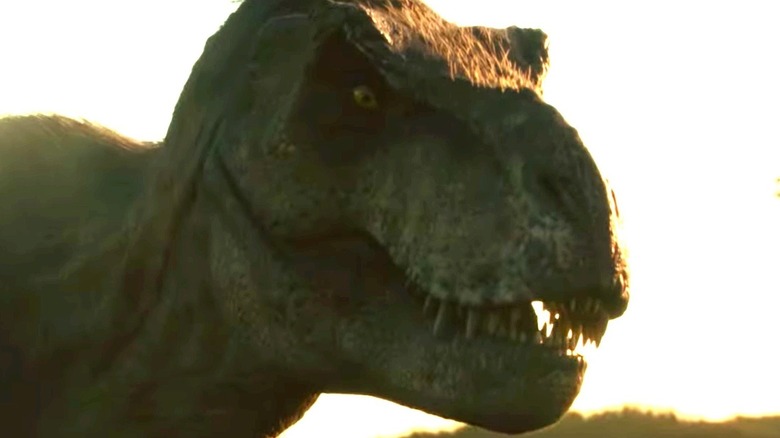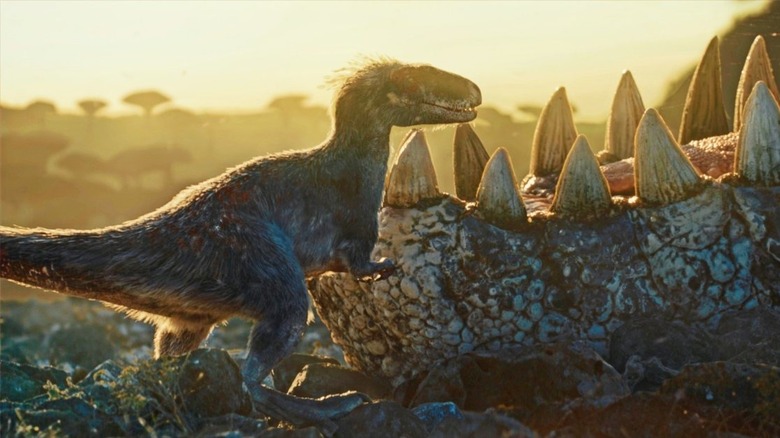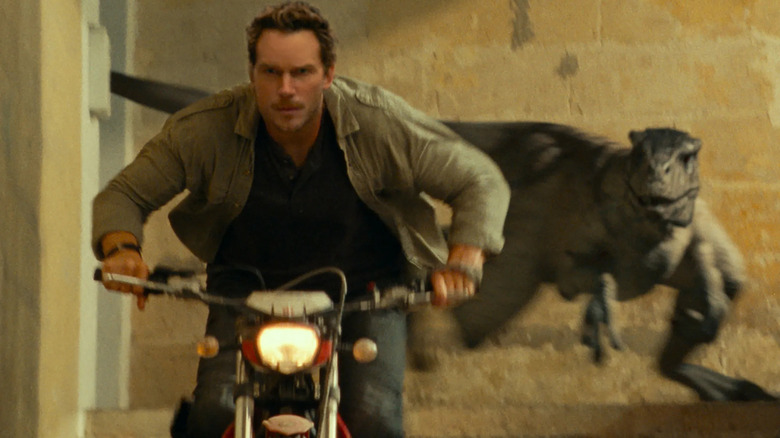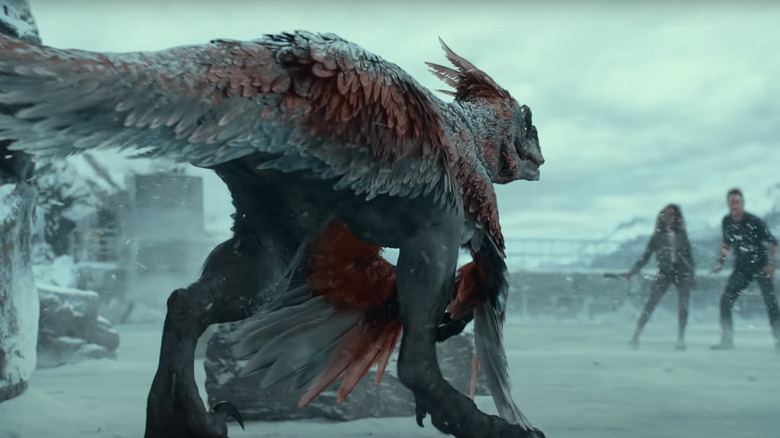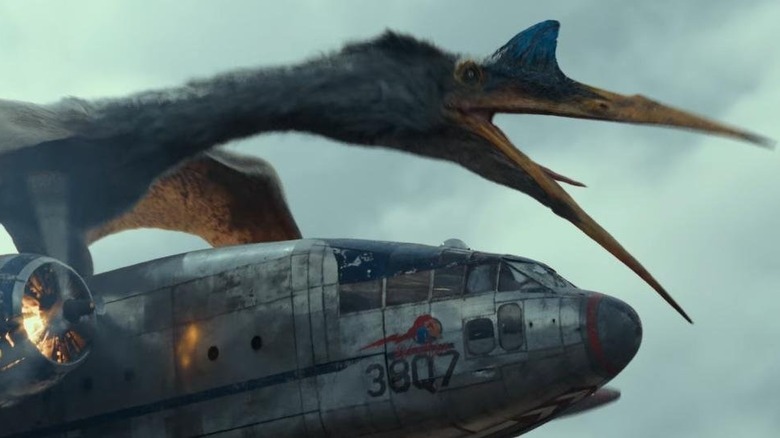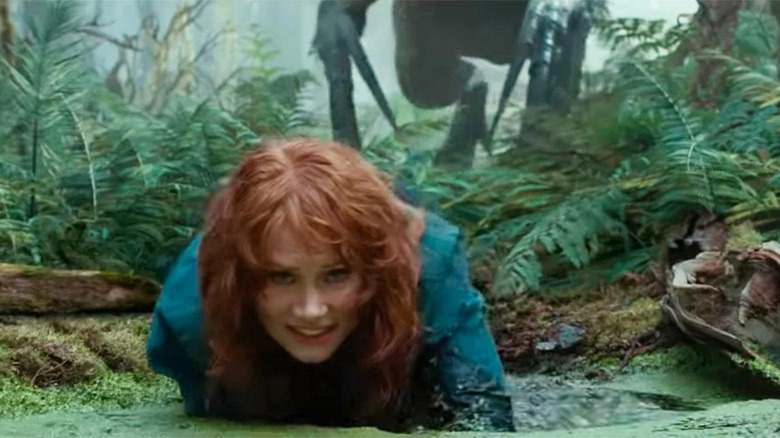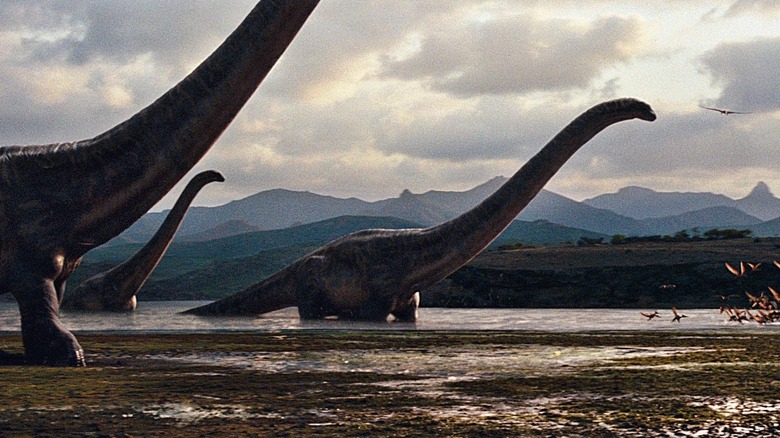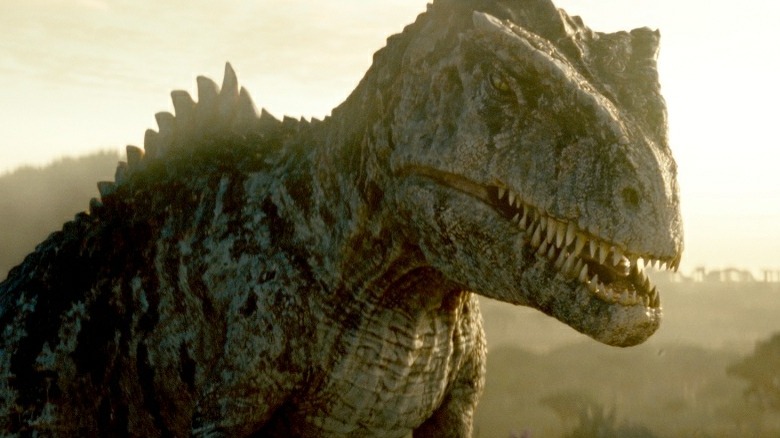Every New Dinosaur Species In Jurassic World Dominion Explained
"Jurassic World Dominion" — the sixth and supposedly final installment of the "Jurassic Park" franchise — has gone back to nature as much as any scientifically suspect film series about dinosaur cloning can. Gone are the horrifying hybrids, Indominus rex and Indoraptor. Added to the existing roster of prehistoric beasts are some species that have only recently been discovered, and might sound and look just as made up to general audiences who aren't familiar with them yet.
Last year, Universal released a five-minute prologue in advance of the movie's marketing campaign. The short included an even more diverse array of dinosaurs, including species like Iguanodon and Nasutoceratops, though that segment doesn't actually appear in the movie. But there are still plenty of new dinosaurs to appreciate, thanks (or no thanks) to Dr. Lewis Dodgson and Biosyn's corrupt sanctuary and cloning program. These are the creatures you can expect to see — all of whom really did exist — in "Jurassic World Dominion."
Moros intrepidus
Biosyn has a Moros intrepidus that can be seen in a glass enclosure when Doctors Grant and Sattler are touring the facilities. Watching it practice its hunting skills with a small mammal, they seem surprised to see that Biosyn has cloned it so quickly. The first Moros fossils were found in 2013, and the genus and species were only classified in February of 2019. Its scientific name means "harbinger of doom," and it was chosen because this small theropod was a sign of bigger, scarier things to come.
In the "Prologue" video, a Moros can be seen cleaning the teeth of a larger predator. In reality, these small but mighty dinosaurs evolved into large predators whose kind spread throughout the continent, and pretty quickly in the grand scheme of things. Paleontologists had long been puzzled by a 70-year gap in which no tyrannosaurs seemed to exist in North America. There were primitive ones from the Jurassic period and ones like the famous T. rex from the late Cretaceous, but nothing in between. Then, a team in Utah found Moros. Like T. rex, Moros lived in North America during the Cretaceous, but he predated his supersized relatives by about 15 million years and probably migrated over a land bridge from Asia, which explains a lot.
As explained by National Geographic, Moros is the missing link that is helping paleontologists understand how tyrannosaurs went from a few feet long to more than 40 feet long. The one depicted in "Jurassic World Dominion" might've been a little on the small side, but its proportions and feathering are probably pretty accurate. This adorably tiny predator was a killer and a survivalist. It was light, fast, and had strong senses with which it could catch prey and evade larger theropods.
Atrociraptor
Every "Jurassic Park" and "Jurassic World" movie features some sort of raptor chase. In "Jurassic World Dominion," black market dinosaur trader Soyona Santos has trained Atrociraptors to respond to laser pointers in the same way the Indoraptor did, and she sets their sights on Owen, Claire, and Barry. Before all hell breaks loose, she refers to Atrociraptors as the thoroughbreds of dinosaurs and claims that nature made a more elegant killer than gene splicing ever could.
Atrociraptor means "atrocious thief." These things would've been slightly closer to human scale than the turkey-sized Velociraptors, and thus slightly more intimidating were we to be pursued by them through the streets of Malta. Paleontologists estimate they would've been around 6 feet in length and around 30-40 pounds, not quite the bulky dinosaur hitmen in the film who clearly outweigh humans. And like Velociraptor, Atrociraptor probably would've been covered in feathers.
We don't know for sure, because even scientists don't know much about this particular species. Some of its skull fragments (mostly jaw parts) were found in the fossil-rich Horseshoe Canyon Formation in Alberta, Canada in 1995 (via The Journal of Vertebrate Paleontology). Paleontologists are still studying those jaw bones today to try to learn more about Atrociraptor and raptor evolution in general. The most atrocious thing about this creature is that its short snout and angled teeth likely meant it had more bite force than the typical raptor and could hold onto its prey with its teeth while it ate it alive.
Pyroraptor
After Owen and Kayla crash through the ice in her plane, they're confronted by an aggressive Pyroraptor who also happens to be an avid swimmer. Pyroraptor means "fire thief," but its scientific name has everything to do with how and where its fossils were found, and not its red plumage or any fantastical fire-breathing abilities. Its full name is Pyroraptor olympius because, as the Journal of Vertebrate Paleontology explains, its remains were discovered at the foot of Mont Olympe after a forest fire in 1992.
As is the case with Atrociraptor, little about Pyroraptor is still understood with any degree of certainty. In fact, Paleontologists aren't even sure it's its own dinosaur. As reported by The Bulletin of the Geological Society of France, the jury is still out on whether the fossils could belong to a Variaraptor. But at least "Jurassic World Dominion" finally shows what a raptor's feathers may have looked like (though we can't blame the original "Jurassic Park," as many of the discoveries that support the existence of feathers on dinosaurs came after the film's release, per Scientific American). While it's great to see a feathered theropod on screen, the franchise can't help itself when it comes to beefing up its Dromaeosaurs for the sake of drama. Pyroraptor would've also been smaller than the one who bursts out from under the ice; it could've been up to 8 feet long with its tail, but its frame and skull would've been thinner.
Quetzalcoatlus
Kayla has a change of heart and offers to fly Claire and Owen to Biosyn to get Maisie back. Since she's dropped illegal cargo for the company before, she thinks she'll be permitted to land. Instead, Dr. Lewis Dodgson — who knows Maisie's guardians are her passengers — turns off a system designed to deter the flighted species that live at the sanctuary from interfering with the planes. Moments later, an enormous pterosaur glides by, and an annoyed Kayla remarks that it's a Quetzalcoatlus from the Cretaceous and that it should've stayed there.
As Science Daily outlines, "Jurassic World Dominion" gets a lot of things right about Quetzalcoatlus, the largest flying creature in history. They hail from North America during the late Cretaceous period. Fossils have been found in Big Bend National Park in Texas. Two different species have been named as of 2021 (Quetzalcoatlus northropi and Quetzalcoatlus lawsoni), but the larger northropi's wingspan could reach lengths of 40 feet. As illustrated in the film, Quetzalcoatlus had a long neck, a long toothless beak, a crest, short legs, no tail, and was covered in hair-like fibers instead of feathers. Their build presented a problem for scientists, who spent years trying to figure out if this behemoth could actually get itself airborne. Research has since shown they probably jumped to give their airplane-sized wings room to flap before they switched to gliding.
In montages, they're shown crouching with bent wings on the ground near the marshes. That's accurate, too — these things were basically giant prehistoric herons or storks.
Therizinosaurus
In one of the more tense scenes of "Jurassic World Dominion," Claire is just about to unbuckle herself from her ejected seat when she sees a deer and hears the low growl of a predator nearby. A Therizinosaurus lurches into the open, and once it's lost interest in the deer, it turns its attention to Claire as she crawls to safety in a thick swamp. In the film's climactic dinosaur battle, the Therizinosaurus teams up with the T. rex to take down a Giganotosaurus by impaling it with its ridiculously long claws.
Therizinosaurus is so named because of those killer claws that, at up to a meter in length, may have been the longest claws in the history of the world (per National Geographic). Therizinosaurus translates to "scythe lizard," and its blade-like appendages would've been its main line of defense against any Tyrannosaurs it may have encountered. "Jurassic World Dominion" gets surprisingly close to what this strange dinosaur would've looked like. As the audience can see in final fight, Therizinosaurus had a much smaller and differently shaped head than other theropods, though it was close in size to T. rex and Giganotosaurus, standing about 15 feet tall and weighting up to 6 tons with a round belly and wide hips. It also probably had feathers.
What's still up for debate is its preferred diet. Based on its bite and body type, some paleontologists have hypothesized (via National Library of Medicine) that it was either an herbivore or an omnivore who mostly snacked on plants and perhaps the occasional small mammal. The claws were likely a defense mechanism, since it couldn't have run fast as a strategy.
Dreadnoughtus
As Doctors Grant and Sattler fly over Biosyn's sanctuary, they spot a Dreadnoughtus. Ramsay says its name means "fears nothing." "Jurassic Park" movies have a history of misrepresenting the meaning of scientific names (Velociraptor does not mean "bird of prey"), but this time, they're spot on. "I thought it was time the herbivores get their due for being the toughest creatures in an environment," said paleontologist Kenneth Lacovara.
Dreadnoughtus was a titanosaur from South America during the Cretaceous. Titanosaurs are known for their epic size, and some even had bony plates embedded in their skin. They were so titanic, as their group name implies, that they probably didn't have to worry about predators — only after one died would scavengers have a chance at it. Of more concern would've been finding enough calories from plant matter to support its enormous body, and enough time in the day to eat whole canopies of trees. The most complete skeleton uncovered in 2014 in Argentina measures 85 feet long, with a 37 foot neck and a 30 foot tail. Paleontologists used digital modeling to estimate it could've weighed 65 tons. Crazier still, that one wasn't fully grown. It's possible Dreadnoughtus could've been the largest land animal of all time (per CNN).
Giganotosaurus
If it holds true that "Jurassic World Dominion" is the last film in the "Jurassic Park" series, then Giganotosaurus is like the final boss, both for the franchise's protagonists and for its first big bad, the T. rex. Giganotosaurus would've been a worthy adversary, though it and T. rex (to say nothing of the Mongolian Therizinosaurus) never would've had the opportunity to spar. The former lived in South America about 30 million years before the latter, which lived in North America. Giganotosaurus was an apex predator, but it wasn't — as the film claims — the largest land predator of all time. It would've been a few feet longer than T. rex (around 45-47 feet), however Spinosaurus still out-measured it at between 50-60 feet, per Live Science.
Size isn't everything, even in gigantic predatory dinosaurs. Giganotosaurus was thinner than T. rex, but that allowed it to be much faster and more agile. It also had a weaker bite force but sharper teeth, so it would've fed differently than its North American counterpart. While T. rex crushed its prey to death, Giganotosaurus may have gone after juvenile dinosaurs and used its teeth to slice through flesh until the animal bled out. "Jurassic World: Dominion" is correct in giving it a strong neck and a distinctive, crested skull. But as cool as they look, there's no evidence to suggest that Giganotosaurus had all those pointy dragon scales on its back.
